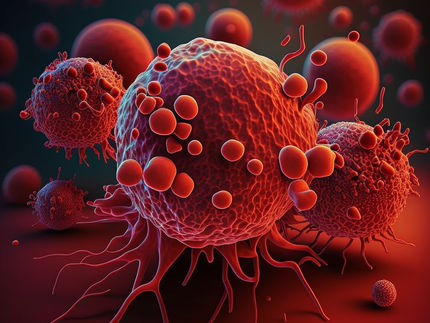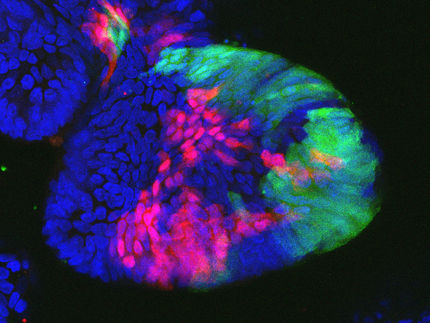Using CRISPR to decipher whether gene variants lead to cancer
There are thousands of mutations in the human genome that are suspected of playing a role in cancer, but whose exact function has never been clarified
Researchers at ETH Zurich have combined two gene editing methods. This enables them to quickly investigate the significance of many genetic mutations involved in the development and treatment of cancer.
In recent years, scientists have created a range of new methods based on CRISPR-Cas technology for precisely editing the genetic material of living organisms. One application is in cell therapy: a patient’s immune cells can be specifically reprogrammed to fight cancer more effectively.
Researchers in the Department of Biosystems Science and Engineering at ETH Zurich in Basel have now found a further application for these novel CRISPR-Cas methods: led by ETH Professor Randall Platt, the researchers are using them to decipher how mutations in a cell’s genome affect its function. The sequence of DNA building blocks in tumour cells, for example, differs from that in healthy cells. With the new approach, the researchers can generate tens of thousands of cells with different gene variants in Petri dishes. They can then decipher which of the variants contribute to the development of cancer and which make the cancer cells resistant to standard drugs.
Combining two methods
Scientists already had the ability to make individual changes to the genome of cells. But the ETH researchers’ project plans were much more complex: they modified one gene in two human cell lines in over 50,000 different ways, thereby creating a correspondingly large number of different cell variants, and then tested the function of those cells. For their proof of concept, they worked with the EGFR gene, which is central to the development of various types of cancer, including lung, brain and breast cancer.
Platt and his team combined two CRISPR-Cas methods to produce a huge number of variants of this gene. Both methods were developed in recent years by researchers at MIT and Harvard University in the United States, and both have advantages and disadvantages. One of these methods, base editing, allows individual building blocks of DNA, known as bases, to be modified very easily and reliably. However, the possibilities of base editing are limited: it can generally switch the DNA base C with the base T, or A with G.
Several tens of thousands of cells changed
The second method the researchers used is prime editing. Theoretically, this method is very powerful: similar to the “search and replace” function of a word processing program, it can change individual sequences of genetic code in a targeted manner. “We can use it to swap any DNA base for another. Or we can insert, say, three or ten bases into the genome or delete the same number,” Platt says. “In principle, you can do whatever you want with it.”
However, prime editing doesn’t work reliably. This has made it difficult to use it to create an entire pool of several tens of thousands of differently modified cells that could then be put through screening. Platt and his team have now achieved this.
Important for oncology
Cell pools with different gene variants are crucial for research. That’s because oncologists are increasingly analysing the genetic information in patients’ tumour cells base by base. This information often gives them clues as to which medication might work for an individual patient.
In recent years, scientists have built databases containing thousands of different genetic variants found in patients. For about half of these variants, the databases also contain a thorough description of their effects. For the other half, all that’s known is that they occur in patients; it’s not clear what impact they have, if any, on the development or treatment of cancer. Scientists refer to these as “variants of uncertain significance”. If a physician finds such a variant in a patient, that information is of little use to them.
Researchers are convinced that oncology would benefit enormously from having more information on these variants. That’s why they’re trying to produce cells with these gene variants in the laboratory, so they can then analyse the function of those cells. In recent years, researchers have done much work in preparation for this possibility. They already had the option of employing base editing as a method, but the problem was that base editing alone isn’t enough. “It only lets you produce around a tenth of these variants,” explains Olivier Belli, a doctoral student in Platt's group and, together with master's student Kyriaki Karava, first author of the study.
New relevant variants found
In order to systematically generate cells with virtually all possible relevant variants of the EGFR gene, Platt and his team first identified the cancer-relevant regions in this gene. These are regions in which mutations either cause a healthy cell to transform into a cancer cell or make a cancer cell become resistant or, conversely, sensitive to a drug. Because it is not possible to create all of these gene variants using base editing, the researches tied in the other method, prime editing.
Finally, the researchers analysed these cells. For ten EGFR gene variants whose effect on cancer progression was previously uncertain, they have now been able to provide evidence that they are significant and describe it: some of these variants may play a role in the onset of cancer, while the others may make it resistant to certain drugs. In the course of this study, the ETH researchers also discovered a potentially new mechanism by which a mutation in the EGFR gene can cause cancer. Moreover, they found six gene variants that appear to play a role in cancer but had never been described – in other words, completely new, relevant gene variants.
The EGFR gene is just one of several hundred human genes associated with cancer. This new research approach is now ready to decode the variants of uncertain significance in all the other genes as well.

























































